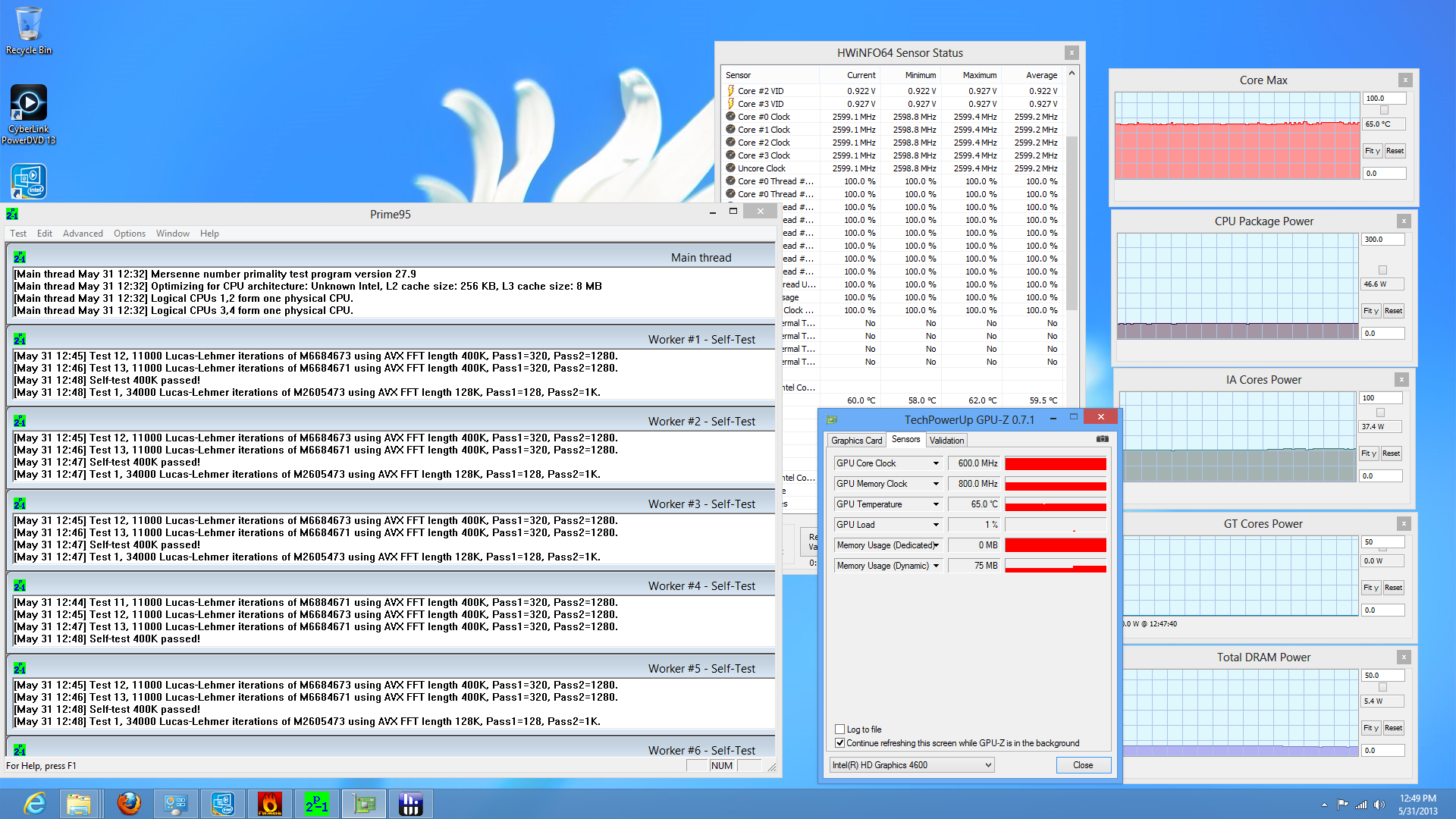Intel's Haswell - An HTPC Perspective: Media Playback, 4K and QuickSync Evaluated
by Ganesh T S on June 2, 2013 8:15 PM ESTPower Consumption
Before proceeding to the business end of the review, let us take a look at some power consumption numbers. The G.Skill RAM was set to DDR3 1600 during the measurements. We measured the average power drawn at the wall under different conditions. In the table below, the Blu-ray movie from the optical disk was played using CyberLink PowerDVD 13. The ISOs were mounted using Windows 8's in-built mounting tool. Prime95 v27.9 and Furmark v1.10.6 were used for stress testing. Blu-ray ISO ripping was done using AnyDVD HD v7.2. The Prime95 + Furmark benchmark was run for 1 hour before any measurements were taken. Power consumption numbers for local file playback using various renderer / decode combinations has already been covered in a previous section. The testbed was connected to a Wi-Fi network (and the GbE port was left unconnected) throughout the evaluation. In all cases, a wireless keyboard and mouse were connected to the testbed.
| Haswell HTPC Testbed Power Consumption | |
| Idle | 25.94 W |
| Sleep | 1.38 W |
| Prime95 v27.9 + Furmark 1.10.6 (Full loading of both CPU and GPU) | 85.68 W |
| Prime95 v27.9 (Full loading of CPU only) | 73.79 W |
| 1080p24 H.264 Blu-ray Playback from ODD | 34.5 W |
| 1080p24 VC-1 Blu-ray Playback from ODD | 33.21 W |
| 1080i60 VC-1 Blu-ray Playback from ODD | 34.37 W |
| 1080p24 VC-1 Blu-ray ISO Streaming from NAS | 30.91 W |
| 1080p24 H.264 MVC Blu-ray ISO Streaming from NAS | 32.67 W |
| Blu-ray Rip to ISO from ODD | 36.41 W |
The following screenshots gives an idea of how the integrated GPU and the CPU share the thermal headroom. In the first case, we have full CPU loading and no load on the GPU.
The CPU package power is around 47 W, with the IA cores alone consuming around 37 W. The second screenshot shows the transition from purely full CPU loading to full CPU and GPU loading. The CPU package power rises from 47 W to around 54 W. The GPU is consuming around 18 W, while the IA cores go down to around 27 W.











95 Comments
View All Comments
Penti - Monday, June 3, 2013 - link
Plus old hardware is old and not available anymore.phoenix_rizzen - Monday, June 3, 2013 - link
Quad-core Athlon-II, CPU fan configured to spin down as needed, case fan unplugged, SSD, nVidia 210 GPU (fanless) running Linux + XBMC. Sub-$300 CDN.Why would you need an i7 for an HTPC? Why would you need a skookum dGPU? And why would you be transcoding on the HTPC? The HTPC should just play the movies on the screen that's attached to it, nothing more. The movies shouldn't reside on the HTPC, and you should be plugging in mobile devices to transfer movies to/from them. That's what the skookum "server" in the other room is for. :)
solnyshok - Wednesday, October 23, 2013 - link
This is quite old thread, but I wanted to add, that it strikes me that my htpc usage model is totally different from the one you described. I use Atom based htpc (dualcore 2.1GHz) which is on 24x7, doing playback to HDMI 1080p tv and torrents and file serving for home network. it is up to 10w and fanless. No MadVR though.benamoo - Monday, June 3, 2013 - link
I'm wondering why no one mentioned the upcoming Ouya console and possibly many more ARM based media player boxes coming to the market next year.I've been an HTPC user for years now, but it's not worth it anymore to invest in such a costly/bulky/noisy system simply for HTPC tasks. Sure, repurposing an old system is great, actually that's what I've been doing, but building a new one from scratch (especially with a Core i7) seems to be a huge waste of money IMO.
I have high hopes for Ouya (and similar ARM/Android powered boxes). Hopefully the experience would be so good that we can finally rid ourselves of this Wintel duopoly.
Don't get me wrong. I still believe an HTPC is the best media center box out there. But these boxes can offer very similar results with a fraction of the cost.
rennya - Wednesday, June 5, 2013 - link
Mainly because those ARM players has crappy GUI and limited support for file formats and containers? Try playing a Matroska file that used segment linking, has a 10-bit H.264 1080p24 video stream with at least 10Mb bitrate, a DTS-HD MA 7.1 track and also a fully-styled SSA subtitle track and you will see that Ouya console crashed and burned while doing so.sireangelus - Tuesday, June 4, 2013 - link
Can someone explain to me why they don't get themselves a laptop with some remote functionality and use that as an htpc? shouldn't it be less expensive, have a lower tdp and be more useful?HisDivineOrder - Tuesday, June 4, 2013 - link
I sincerely hope they fixed the 23.976 bug in the IGP that is included with Bay Trail. If they did, there's your HTPC of choice for anyone not obsessed with MadVR.halbhh2 - Tuesday, June 4, 2013 - link
Such a careful review makes me want to have the new A10 6700 put through the same paces.majorleague - Wednesday, June 5, 2013 - link
Here is a youtube link showing 3dmark11 and windows index rating for the 4770k 3.5ghz Haswell. Not overclocked.Youtube link:
http://www.youtube.com/watch?v=k7Yo2A__1Xw
eio - Saturday, June 22, 2013 - link
according to the snapshots, to my eyes, the QSV quality of HD4600 is significantly better than HD4000 & x264...